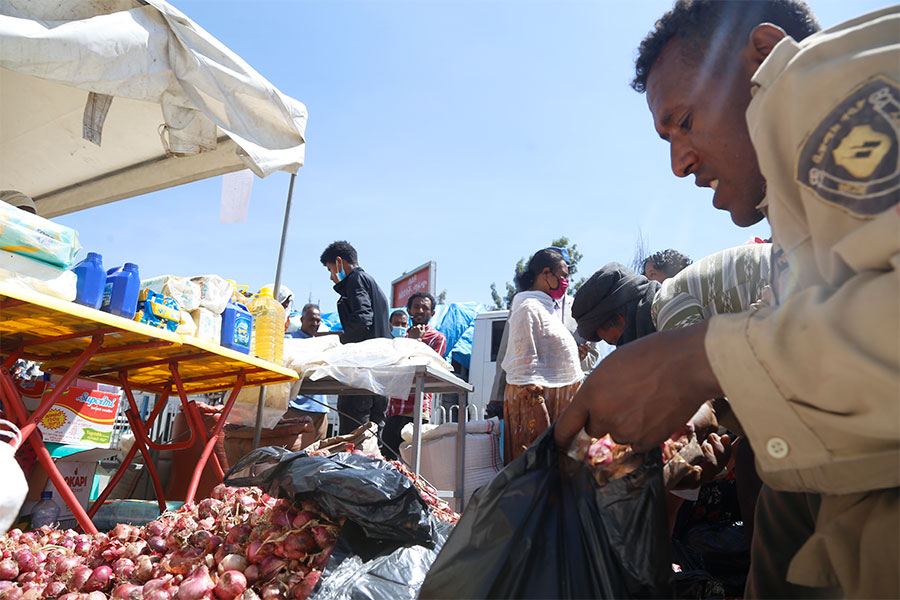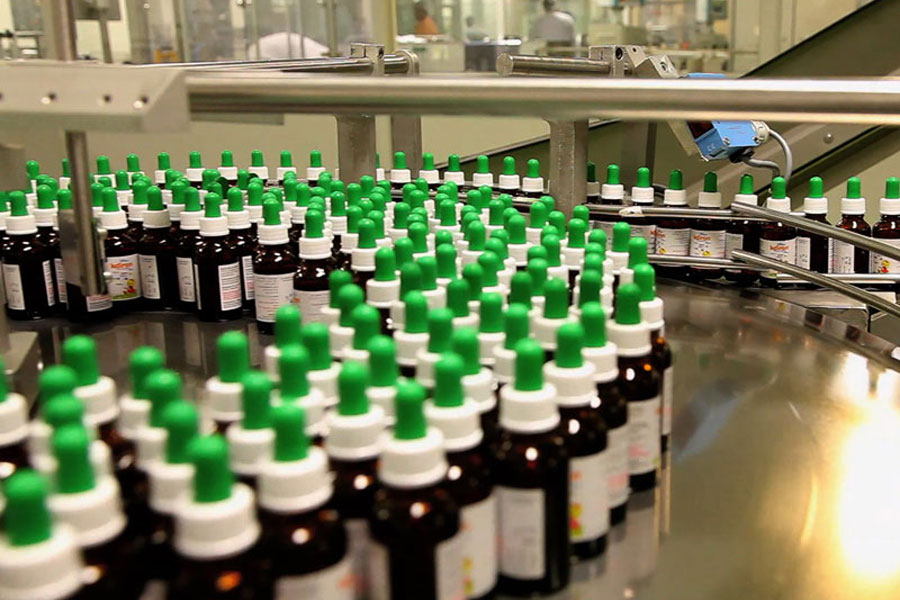
Fortune News | Nov 27,2021
The pharmaceutical industry is moving to export products overseas, with major domestic companies planning to venture into neighbouring markets within the next two years.
Kilitch Estro Biotech Plc, Glocare Pharma Manufacturing Plc, and Pharmacure Plc, constituenting of the 24-member Ethiopian Pharmaceuticals Suppliers & Manufacturers Sectoral Association (EPSMSA), have collective vision to penetrate markets beyond Ethiopia`s borders.
Daniel Waktola, the manager of Kilitch, is optimistic about the potential ahead.
"Ethiopia's membership in regional trade blocs such as COMESA will open doors for us," he told Fortune. "We're positioned at the threshold of lucrative markets."
Daniel, president of the Association, has a 33pc ownership stake at Kilitech, while an assortment of Indian investors owns the rest. He portrayed a glimpse of the future.
"We're on the cusp of sealing deals with buyers from Kenya and Sudan," he disclosed.
Kilitch, a notable pharma in the domestic market, is poised to cater to the rising demand. With the ability to produce 90 million vials of injectable medicines annually, only a third of which meets domestic demand; there lies an untapped potential.
"We can export the surplus," he asserted.
This optimism is not limited to business corridors.
The Armen Hansen Research Institute (AHRI) has set an encouraging precedent, completing preparations to issue bioequivalence inspection certificates, a vital step for pharmaceutical exports. Initially set up in collaboration with Norwegian and Swedish Save the Children initiatives in the early 1970s, the Institute has over 900 published research papers.
Last week, a meeting at the Inter-Luxury Hotel allowed the companies to showcase their ambitious projects in the pipeline. The conclave saw the presence of the ministers of Industry and Health, Melaku Alebel and Lia Tadesse (MD), respectively. Representatives from the pharmaceutical supply and regulatory sectors were also present, where Daniel proposed to the attending officials to create an export promotion council. He emphasised that streamlining customs procedures and accessing better credit facilities is vital to ensure the pharma industry can produce at its optimum capacity.
The meeting was privy to an encouraging address by the State Minister for Finance, Eyob Tekalegn (PhD). While he kept the specifics close to his chest, his optimism about the impending second edition of the Homegrown Economic Reform was noticeable.
"Ethiopia presents its challenges for businesses," he acknowledged. "But there is promise on the horizon."
Despite the industry's aspirations, the pharmaceutical export sector has seen more misses than hits. Notables like Cadila Pharmaceuticals, Sino Ethiopia, Julphar Ethiopia, and the National Veterinary Institute have all tried to break into the export market without noteworthy success.
A mere eight percent of the country's total pharmaceutical stock is supplied by local manufacturers, down from a significant 25pc at their prime. Only 13pc of the 800 medicines procured for 10 billion Br was supplied by domestic pharma, with the state-enterprise providing 75pc.
"The trend has been declining," Solomon Nigussie, deputy head of the Ethiopian Pharmaceutical Supply Services Enterprise (EPSSE), noted, suggesting that the export venture might rejuvenate the domestic industry's stakes.
However, a silver lining seems to be emerging. Solomon disclosed plans for the Enterprise to ink deals with domestic manufacturers, ensuring that half of the state-owned enterprise's purchase would be sourced domestically, benefitting from a new foreign currency modality currently under discussion.
A recent federal governmental circular hinted at the winds of change. Two months ago, State Minister Eyob rolled out a helping measure, earmarking 55pc of the forex required for pharmaceutical production inputs. The industry sees this move as a robust incentive to bolster production.
However, challenges persist. A consistent issue flagged by local manufacturers, which employ around 6,000 people, is the scarcity of foreign currency. This has been a significant impediment, coupled with protracted customs clearance hurdles, forcing them to produce below capacity.
Fikadu Tefera, the Association's general manager, hopes the foraying into export markets could be the lifeline these companies need. He drew parallels with Humanwell Pharmaceutical Ethiopia Plc's recent success in exporting a sizable amount to West Africa, spotlighting the untapped potential. Incorporated seven years ago with a 25 million dollar capital, the company has its plant erected in a seven-hectare land in Bulga, north Shewa Zone of the Amhara Regional State.
According to the company's senior executives, Humanwell Pharmaceutical operates at one-third of its capacity while the remaining is contingent on a pending construction.
Fiseha Woldegiorgis, a senior manager at Humanwell, noted their ambitious plans to almost double exports to countries like Mali and Niger.
"Local sales don't meet our forex needs," he told Fortune.
Mesay Woldemariam, head of pharmaceutical development at AHRI, agreed. He believes exports allow domestic manufacturers to expand their horizons, from focusing on local markets. AHRI joined the Ethiopian Ministry of Health in 2004 and became a federal health agency in 2016. While the Institute developed a roadmap for bioequivalence certification of drugs locally manufactured, it has not received export proposals from the producers.
It will soon commence a bioequivalence test using donors' equipments, although Mesay disclosed that it is not the main barrier to pharmaceutical exports.
"Other bottlenecks exist in the sector," he told Fortune.
According to a study the Association commissioned, turnover of the Ethiopian pharmaceutical market is expected to reach 1.8 billion dollars by 2025, while it was estimated to be worth 450 million dollars a decade ago. The food, drugs and pharmaceutical industry generated 64 million dollars from exports during the half year of 2022, registering a 36.8pc growth from the same period in the previous year. It is a sharp contrast to the decline in the imports of medical and pharmaceuticals, dropping by 44.3pc to 194 dollars during the first five months of last year.
Experts such as Getasew Amare, a veteran health economist, emphasised the need for expanded private sector engagement while recognising the move by the manufacturers as keeping in line with their needs to raise considerable working capital.
"The majority of health financing is foreign-funded," he told Fortune.
He points to health officials' lack of autonomous decision-making as a significant contributor to the underdevelopment of a thriving private manufacturing pharmaceutical sector. The health economist highlighted the importance of independent decision-making to craft viable and sustainable supply chains.
"I don't believe the supply service [the state-enterprise] exercises full autonomy in procurements," he told Fortune.
PUBLISHED ON
[ VOL
, NO
]

Fortune News | Nov 27,2021

Fortune News | Nov 09,2019

My Opinion | Jul 09,2022

Fortune News | Feb 23,2019

News Analysis | Sep 01,2024

Radar | Mar 02,2024

Commentaries | Apr 24,2021

Featured | Jan 03,2021

Editorial | Jun 15,2024

Fortune News | Oct 27,2024

Dec 22 , 2024 . By TIZITA SHEWAFERAW
Charged with transforming colossal state-owned enterprises into modern and competitiv...

Aug 18 , 2024 . By AKSAH ITALO
Although predictable Yonas Zerihun's job in the ride-hailing service is not immune to...

Jul 28 , 2024 . By TIZITA SHEWAFERAW
Unhabitual, perhaps too many, Samuel Gebreyohannes, 38, used to occasionally enjoy a couple of beers at breakfast. However, he recently swit...

Jul 13 , 2024 . By AKSAH ITALO
Investors who rely on tractors, trucks, and field vehicles for commuting, transporting commodities, and f...

Jul 12 , 2025
Political leaders and their policy advisors often promise great leaps forward, yet th...

Jul 5 , 2025
Six years ago, Ethiopia was the darling of international liberal commentators. A year...

Jun 28 , 2025
Meseret Damtie, the assertive auditor general, has never been shy about naming names...

Jun 21 , 2025
A well-worn adage says, “Budget is not destiny, but it is direction.” Examining t...